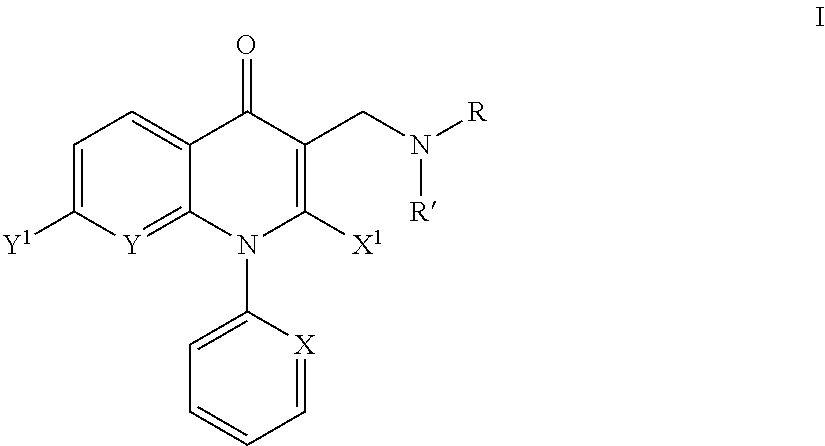Aminomethyl quinolone compounds
a technology of aminomethyl quinolone and compound, applied in the field of aminomethyl quinolone compounds, can solve the problems of malignant tumor formation, debilitating joint damage and deformation of most ra patients, and endangering the health of patients' health
- Summary
- Abstract
- Description
- Claims
- Application Information
AI Technical Summary
Benefits of technology
Problems solved by technology
Method used
Image
Examples
examples
[0486]The following preparations and examples are given to enable those skilled in the art to more clearly understand and to practice the present invention. They should not be considered as limiting the scope of the invention, but merely as being illustrative and representative thereof.
Abbreviations
Ac2O Acetic anhydride
AcOH Acetic acid
DBU 1,8-Diazabicyclo[5.4.0]undec-7-ene
DCE 1,2-Dichloroethane
DCM Dichloromethane / Methylene chloride
DIPEA Diisopropylethylamine
DMF N,N-dimethylformamide
DMSO Dimethyl sulfoxide
EDCI 1-(3-Dimethylaminopropyl)-3-ethylcarbodiimide hydrochloride
Et2O Diethyl ether
EtOAc Ethyl acetate
HOBt 1-Hydroxybenzotriazole
LDA Lithium diisopropylamide
LiHMDS Lithium bis(trimethylsilyl)amide
m-CPBA 3-Chloroperoxybenzoic acid
MeOH Methanol / Methyl alcohol
MW Microwaves
NMP 1-Methyl-2-pyrrolidinone
PMB 4-Methoxy benzyl
TBME tert-Butyl methyl ether
Tf2O Trifluoromethanesulfonic anhydride
THF Tetrahydrofuran
TLC Thin layer ...
example i-1
1-Benzyl-2-oxo-1,2-dihydro-pyridine-4-carboxylic acid (7-chloro-2-oxazol-2-yl-4-oxo-1-phenyl-1,4-dihydro-quinolin-3-ylmethyl)-amide
[0631]
[0632]In a 10 mL round-bottomed flask, 1-benzyl-2-oxo-1,2-dihydropyridine-4-carboxylic acid (32.6 mg, 0.142 mmol), bromo-tris-pyrrolidino-phosphonium hexafluorophosphate (PyBrOP) (66.3 mg, 0.142 mmol) and N,N-diisopropylethylamine (73.5 mg, 0.099 mL, 0.569 mmol) were combined with DMF (2 mL). The reaction mixture was stirred at room temperature for 10 min. After this time, 3-aminomethyl-7-chloro-2-oxazol-2-yl-1-phenyl-1H-quinolin-4-one (intermediate A) was added (0.050 g, 0.142 mmol). The reaction mixture was stirred at room temperature for 3 hr. The product was purified using flash chromatography (40% ethyl acetate / hexane ramped to 100% ethyl acetate / hexanes). MS calcd. for C32H24ClN4O4 [(M+H)+] 563.1, obsd. 563.3.
examples i-2 to i-5
[0633]The following examples I-2 to I-5 were prepared in an analogous manner to example I-1, starting with intermediate A, an appropriate commercially available carboxylic acid, and a commercially available amide coupling reagent (for example, bromo-tris-pyrrolidino-phosphonium hexafluorophosphate (PyBrOP) or 1-(3-dimethylaminopropyl)-3-ethylcarbodiimide hydrochloride (EDC) and 1-hydroxybenzotriazole (HOBT).
PUM
 Login to View More
Login to View More Abstract
Description
Claims
Application Information
 Login to View More
Login to View More - R&D
- Intellectual Property
- Life Sciences
- Materials
- Tech Scout
- Unparalleled Data Quality
- Higher Quality Content
- 60% Fewer Hallucinations
Browse by: Latest US Patents, China's latest patents, Technical Efficacy Thesaurus, Application Domain, Technology Topic, Popular Technical Reports.
© 2025 PatSnap. All rights reserved.Legal|Privacy policy|Modern Slavery Act Transparency Statement|Sitemap|About US| Contact US: help@patsnap.com



